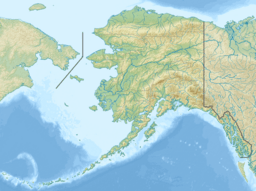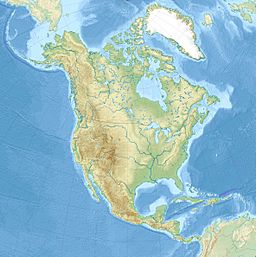Imuruk Basin facts for kids
Quick facts for kids Imuruk Basin |
|
|---|---|

View of the Imuruk Basin from the north.
|
|
| Location | Nome Census Area, Alaska, United States |
| Coordinates | 65°07′14″N 165°42′00″W / 65.12056°N 165.70000°W |
| Primary inflows | |
| Primary outflows | Tuksuk Channel |
| Basin countries | United States |
| Surface area | ~90 sq mi (230 km2) |
| Max. depth | 20 feet (6 m) |
| Surface elevation | 3 feet (1 m) |
The Imuruk Basin (called Imaġruk by the Iñupiaq people) is a large, shallow body of water in Alaska. It's like a big bay where fresh river water mixes with salty ocean water. This type of water body is called an estuary.
The Imuruk Basin covers about 90 square miles. That's roughly the size of 57,000 football fields! It is about 17 miles long and fairly shallow, reaching a maximum depth of about 20 feet.
Contents
Where is the Imuruk Basin Located?
The Imuruk Basin is found on the Seward Peninsula in the state of Alaska, U.S.. The Seward Peninsula is a large piece of land that sticks out into the Bering Sea. The basin's water area is a very important part of the peninsula's natural environment.
How Water Flows Through the Basin
The Imuruk Basin gets its fresh water from several rivers. These include the Kuzitrin River, the Kruzgamepa River, the Agiapuk River, and the Cobblestone River. These rivers carry water from the land into the basin.
From the basin, the water flows out through a narrow passage called the Tuksuk Channel. This channel then empties into Grantley Harbor, which is part of the Pacific Ocean. This constant flow of water makes the Imuruk Basin a dynamic and interesting estuary.
Why Is the Imuruk Basin Important?
The Imuruk Basin has been important to the people of Alaska for a very long time. It served as a key travel route for the early Iñupiat people.
Today, the Imuruk Basin is an important source of water and food for Iñupiat people. For generations, they have gathered food here. They fish in the waters, hunt for animals like seals, and find birds like ducks and geese.
People from the city of Nome also come to these rivers and streams to fish and hunt. This land helps feed and support many families in the region.
Threats
People are planning to build a very large graphite mine near the Imuruk Basin. This mine could damage the land and water that animals need to live. For the communities who live there, this means it could become much harder to find enough food from hunting and fishing.



